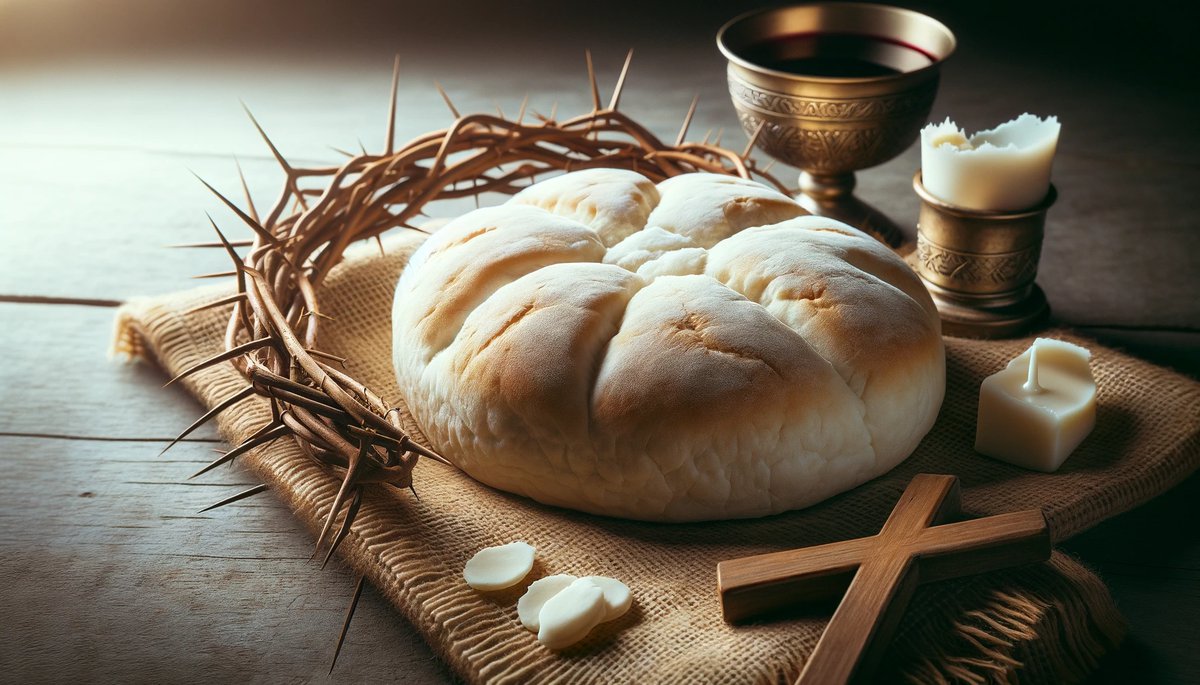Home>Theology and Spirituality>What Does Communion Bread Taste Like


Theology and Spirituality
What Does Communion Bread Taste Like
Published: February 19, 2024
Ericka Andersen, an editor at Christian.net, expertly merges digital strategy with content creation, focusing on faith and societal issues. Her communication skills enhance the platform's engaging narratives, fostering meaningful dialogue on belief's impact on society.
Discover the taste of communion bread and its significance in theology and spirituality. Explore the flavors and symbolism behind this sacred tradition.
(Many of the links in this article redirect to a specific reviewed product. Your purchase of these products through affiliate links helps to generate commission for Christian.net, at no extra cost. Learn more)
Table of Contents
Introduction
Communion, also known as the Eucharist or the Lord's Supper, holds profound significance in Christian faith and practice. At the heart of this sacred ritual is the communion bread, a simple yet symbolically rich element that has been a cornerstone of Christian worship for centuries. The communion bread, often unleavened and modest in appearance, carries deep spiritual meaning and serves as a tangible representation of the body of Christ.
As believers gather to partake in this sacred act, the communion bread becomes a focal point of reverence and reflection. Its taste, texture, and symbolism evoke a sense of unity, remembrance, and spiritual nourishment for those who participate in the communion service. In this article, we will delve into the history, ingredients, taste, variations, and significance of communion bread, offering a comprehensive exploration of this cherished element within Christian traditions.
Read more: What Does The Bread Represent In Communion
The History of Communion Bread
The history of communion bread is deeply intertwined with the origins of the Christian faith and the establishment of the Eucharistic tradition. Dating back to the Last Supper, a pivotal event in Christian theology, communion bread holds a venerable place in the annals of religious history.
The practice of sharing bread as a sacred rite can be traced to the accounts of the Last Supper, where Jesus Christ, in the company of his disciples, partook in a meal that would become the foundation of the Eucharist. According to the New Testament, during this momentous gathering, Jesus took bread, blessed it, broke it, and gave it to his disciples, instructing them to consume it as a representation of his body. This act of sharing bread, imbued with profound spiritual significance, laid the groundwork for the ritual of communion that would be perpetuated by generations of Christians.
In the early Christian church, the tradition of partaking in the Eucharist, which included the consumption of bread and wine, became a central element of worship and communal fellowship. The practice of using unleavened bread, reminiscent of the bread consumed during the Passover meal at the Last Supper, became customary in many Christian communities. Over time, various cultural and regional influences gave rise to diverse forms of communion bread, reflecting the rich tapestry of Christian traditions across different denominations and geographical locations.
Throughout history, the significance of communion bread has been underscored by theological debates, liturgical developments, and the evolution of Christian worship practices. The symbolism of the bread as the body of Christ, the act of sharing it in remembrance of Jesus' sacrifice, and the communal aspect of partaking in the Eucharist have all contributed to the enduring legacy of communion bread within Christian spirituality.
As Christianity spread across continents and diversified into numerous denominations, the practice of communion and the role of communion bread evolved, adapting to cultural contexts while retaining its fundamental symbolism and spiritual import. Today, the history of communion bread stands as a testament to the enduring legacy of the Eucharistic tradition and its profound significance in the lives of believers worldwide.
The Ingredients of Communion Bread
The ingredients of communion bread are a fundamental aspect of its significance and symbolism within Christian worship. Traditionally, communion bread is made from simple and pure elements, reflecting the humble nature of the ritual and its spiritual connotations. While specific recipes may vary among different Christian denominations and traditions, the core ingredients typically adhere to the essential principles of simplicity and reverence.
Unleavened wheat flour, often referred to as "pure wheat" flour, is a primary component of communion bread. This choice of flour aligns with the historical context of the Last Supper, where unleavened bread was likely used, as it was the custom during the Jewish Passover meal. The absence of leaven, which causes bread to rise, symbolizes purity and sincerity, emphasizing the solemnity of the Eucharistic observance.
In addition to pure wheat flour, water is commonly used to form the dough for communion bread. The simplicity of this combination underscores the unadorned nature of the bread, emphasizing its role as a symbol of Christ's body in its purest form. The act of mixing flour and water to create the communion bread dough reflects the blending of basic elements to form a unified whole, mirroring the unity of believers in the body of Christ.
While the traditional ingredients of communion bread are minimal, some variations may incorporate a small amount of salt. This addition serves as a reminder of the "salt of the earth" metaphor found in the teachings of Jesus, emphasizing the role of believers in preserving and enhancing the spiritual flavor of the world through their faith and actions.
The deliberate simplicity of the ingredients used in communion bread underscores the spiritual significance of the Eucharist and the solemn act of partaking in the body of Christ. By adhering to minimal and pure elements, communion bread serves as a tangible representation of the sacred bond between believers and the enduring legacy of Christ's sacrifice.
The careful selection and preparation of these ingredients reflect the reverence and spiritual intention behind the communion bread, emphasizing its role as a symbol of unity, remembrance, and spiritual nourishment within the Christian faith.
The Taste of Communion Bread
The taste of communion bread, often described as subtle and plain, carries profound spiritual significance within the context of Christian worship. As believers partake in the Eucharist, the act of consuming communion bread transcends mere sensory experience, evoking a deeper connection to the spiritual symbolism it embodies.
Communion bread, typically made from unleavened wheat flour and water, offers a delicate texture and a mild, slightly earthy flavor. Its simplicity is intentional, serving as a poignant reminder of the humility and purity associated with the body of Christ. The absence of elaborate seasonings or embellishments underscores the solemnity of the Eucharistic ritual, directing focus towards the spiritual essence of the act rather than sensory indulgence.
The taste of communion bread, while unassuming, carries profound symbolism for those who partake in the sacred ritual. Its understated flavor serves as a metaphor for the selfless and unadorned nature of Christ's sacrifice, inviting believers to reflect on the essence of spiritual nourishment and the unity of the body of Christ. The act of consuming communion bread becomes a contemplative experience, prompting individuals to internalize the significance of Christ's body as a source of sustenance for the soul.
The subtle taste of communion bread also fosters a sense of communal participation and shared reverence among worshippers. As individuals partake in the Eucharist, the unassuming flavor of the bread unites them in a collective act of remembrance and spiritual nourishment, transcending individual preferences and palates to emphasize the shared faith and devotion of the worshipping community.
In essence, the taste of communion bread, though modest, serves as a poignant reminder of the spiritual depth and communal significance inherent in the Eucharistic tradition. Its unpretentious flavor invites believers to engage in a reflective and reverent experience, drawing attention to the profound symbolism of Christ's body as a unifying and sustaining force within the Christian faith.
Variations of Communion Bread
Variations of communion bread reflect the diverse cultural, regional, and denominational influences within Christian traditions. While the fundamental symbolism and spiritual significance of communion bread remain consistent across different denominations, the specific forms and preparations of the bread exhibit a rich tapestry of diversity and historical context.
Unleavened Wafers
Unleavened wafers, often thin and crisp, are a prevalent form of communion bread in many Christian traditions. These delicate wafers, resembling thin discs, are meticulously prepared to align with the tradition of using unleavened bread during the Last Supper. Their uniform shape and texture symbolize the unity and consistency of Christ's sacrifice and the unbroken bond of fellowship among believers.
Homemade Loaves
In some Christian communities, particularly those with a strong emphasis on communal participation and shared rituals, homemade loaves of communion bread are utilized. These rustic loaves, often baked by members of the congregation, embody a sense of communal involvement and personal dedication to the Eucharistic observance. The irregular shapes and textures of these loaves reflect the diverse contributions of the worshipping community, underscoring the collective nature of the Eucharistic tradition.
Gluten-Free Options
In response to the dietary needs and sensitivities of congregants, many churches offer gluten-free variations of communion bread. These alternatives, often made from non-gluten flours such as rice or tapioca, ensure that individuals with gluten intolerances can fully participate in the Eucharistic ritual. The availability of gluten-free communion bread exemplifies the inclusive and accommodating nature of Christian worship, affirming the accessibility of the Eucharist to all members of the faith community.
Intercultural Influences
In regions where Christianity has intersected with diverse cultural practices, communion bread may exhibit unique influences from local culinary traditions. For example, in certain Latin American communities, communion bread may take the form of tortillas, reflecting the cultural heritage and culinary customs of the region. These intercultural variations of communion bread serve as a testament to the adaptability of Christian rituals within different global contexts, embracing the rich diversity of worship expressions while upholding the central tenets of the Eucharistic tradition.
Read more: What Bread Is Used For Communion
Artisanal Creations
In contemporary settings, some churches incorporate artisanal and creatively crafted communion bread, elevating the ritual to an aesthetic and sensory experience. Artisanal variations may feature intricate designs, diverse textures, and nuanced flavors, offering a heightened sensory engagement while maintaining the solemn symbolism of the Eucharist. These artisanal creations underscore the intersection of spirituality and creativity, inviting worshippers to encounter the sacred through a blend of artistry and tradition.
The diverse variations of communion bread, ranging from traditional unleavened wafers to culturally influenced forms, exemplify the dynamic and inclusive nature of the Eucharistic tradition within the global tapestry of Christian worship. While the core symbolism of the bread remains constant, the array of variations reflects the adaptability and richness of the Eucharistic ritual across diverse denominational, cultural, and culinary landscapes.
The Significance of Communion Bread in Different Christian Traditions
The significance of communion bread varies across different Christian traditions, reflecting diverse theological perspectives, historical legacies, and cultural contexts. Within each tradition, the communion bread holds profound symbolism and spiritual import, shaping the worship experience and fostering a deep sense of connection to the central tenets of the Christian faith.
Catholic Tradition
In the Catholic tradition, communion bread, known as the "host," is regarded with utmost reverence as it undergoes the process of transubstantiation during the Eucharistic celebration. According to Catholic doctrine, the consecrated host is believed to become the actual body of Christ while retaining the appearance of bread. This transformation, known as the Real Presence, underscores the profound spiritual reality of Christ's sacrificial offering. The communion bread, therefore, serves as a focal point of adoration and worship, inviting believers to encounter the divine presence in a tangible and transformative manner.
Orthodox Tradition
In Orthodox Christian traditions, the preparation and handling of communion bread adhere to meticulous liturgical guidelines, emphasizing the sacred nature of the Eucharistic elements. The communion bread, or "prosphora," is intricately stamped with religious symbols and inscriptions, reflecting the theological significance of the Eucharist as a communal and sacrificial act. The prosphora, prepared with reverence and precision, symbolizes the unity of the faithful and the sanctity of Christ's body within the context of Orthodox worship.
Read more: What Is Communion Bread Called
Protestant Traditions
Across various Protestant denominations, the significance of communion bread encompasses a spectrum of interpretations, ranging from symbolic remembrance to spiritual participation in Christ's sacrifice. In some Protestant traditions, such as Lutheranism, the communion bread is viewed as a means of grace, signifying the spiritual nourishment and communion with Christ experienced by believers during the Eucharistic observance. In contrast, denominations like the Baptist tradition emphasize the symbolic nature of communion, highlighting the act of remembrance and the proclamation of Christ's redemptive work through the shared consumption of bread and wine.
Evangelical and Charismatic Traditions
Within evangelical and charismatic Christian traditions, communion bread holds significance as a tangible expression of spiritual unity and covenantal relationship with God and fellow believers. The act of partaking in communion bread is often accompanied by fervent prayer, worship, and a sense of communal anticipation, reflecting the emphasis on personal faith and experiential encounter with the presence of Christ during the Eucharistic gathering.
Global and Indigenous Expressions
In regions where Christianity intersects with diverse cultural and indigenous practices, the significance of communion bread takes on unique expressions, incorporating local culinary traditions, symbolic motifs, and communal rituals. These diverse manifestations of communion bread underscore the adaptability and inclusivity of the Eucharistic tradition within the global tapestry of Christian worship, affirming the universal relevance of Christ's sacrificial offering across diverse cultural landscapes.
In essence, the significance of communion bread in different Christian traditions reflects the multifaceted nature of the Eucharistic tradition, encompassing theological, liturgical, and cultural dimensions that resonate deeply within the hearts and minds of believers worldwide. The communion bread serves as a unifying symbol, bridging diverse traditions and theological perspectives while affirming the central role of Christ's body in the spiritual nourishment and communal fellowship of the Christian faith.
Conclusion
In conclusion, the communion bread stands as a timeless symbol of spiritual nourishment, communal fellowship, and profound reverence within the Christian faith. From its historical roots in the Last Supper to its diverse expressions across global Christian traditions, the communion bread embodies the enduring legacy of Christ's sacrifice and the unifying bond of believers in the body of Christ.
The history of communion bread, rooted in the foundational accounts of the Last Supper, underscores its integral role in the Eucharistic tradition. Across centuries, the practice of sharing bread as a sacred rite has remained a cornerstone of Christian worship, reflecting the enduring significance of the communion bread in the lives of believers.
The deliberate simplicity of the ingredients used in communion bread, including unleavened wheat flour and water, serves as a poignant reminder of the humility and purity associated with the body of Christ. This intentional minimalism underscores the spiritual significance of the Eucharist and the solemn act of partaking in the body of Christ.
The taste of communion bread, though modest, carries profound symbolism, inviting believers to engage in a reflective and reverent experience. Its unassuming flavor fosters a sense of communal participation and shared reverence among worshippers, transcending individual preferences to emphasize the shared faith and devotion of the worshipping community.
The diverse variations of communion bread, ranging from traditional unleavened wafers to culturally influenced forms, exemplify the dynamic and inclusive nature of the Eucharistic tradition within the global tapestry of Christian worship. While the core symbolism of the bread remains constant, the array of variations reflects the adaptability and richness of the Eucharistic ritual across diverse denominational, cultural, and culinary landscapes.
In different Christian traditions, the communion bread holds profound significance, shaping the worship experience and fostering a deep sense of connection to the central tenets of the Christian faith. Whether in Catholic, Orthodox, Protestant, evangelical, charismatic, or indigenous expressions, the communion bread serves as a unifying symbol, bridging diverse traditions and theological perspectives while affirming the central role of Christ's body in the spiritual nourishment and communal fellowship of the Christian faith.
In essence, the communion bread transcends its humble appearance and subtle taste to become a powerful emblem of unity, remembrance, and spiritual sustenance for believers worldwide. Its enduring presence within the Eucharistic tradition serves as a testament to the timeless significance of Christ's sacrifice and the unifying bond of fellowship that defines the Christian faith.












